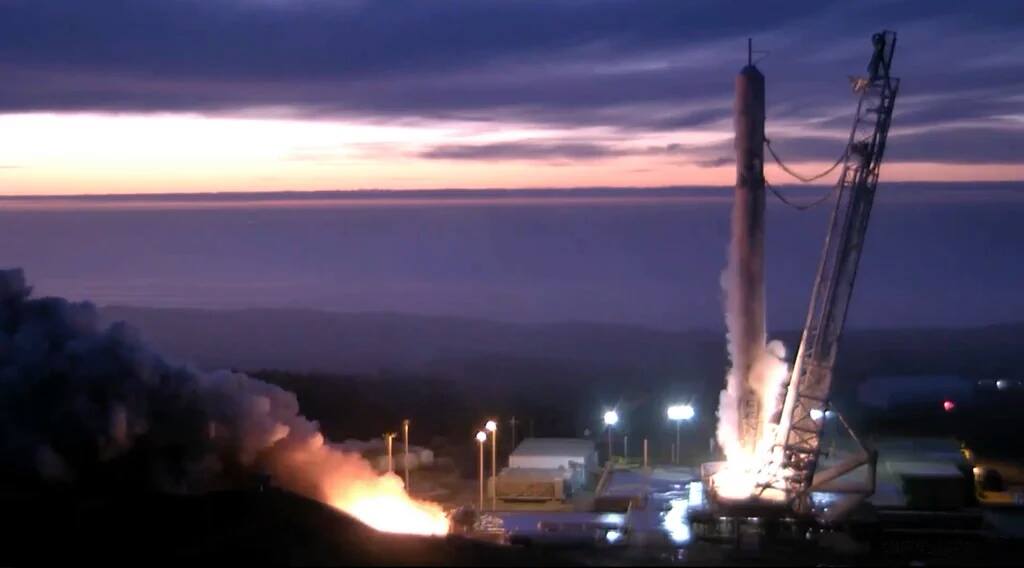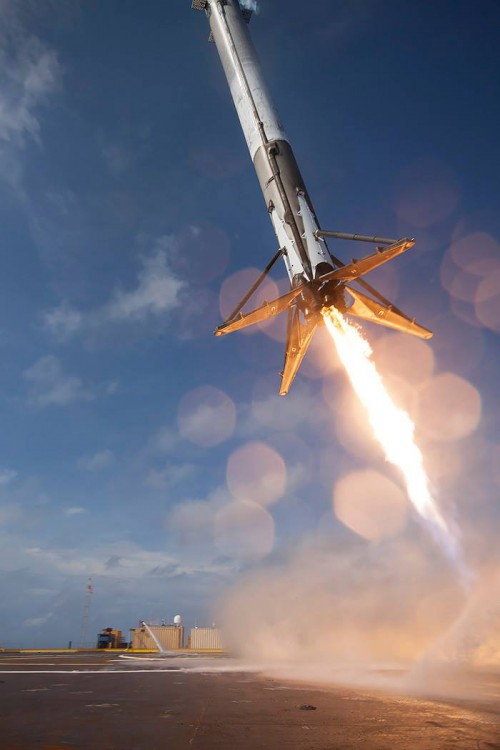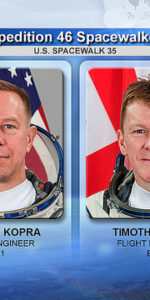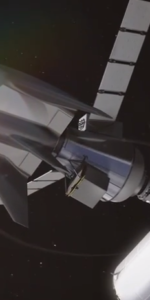
This Sunday (Jan. 17) SpaceX is scheduled to kick off a busy 2016 space launch manifest for the United States, aiming to deliver the Jason-3 satellite to orbit from Vandenberg AFB (VAFB) in Southern California for the National Oceanic and Atmospheric Administration (NOAA), NASA, and France. The Earth-observing satellite is being mated atop SpaceX’s Falcon-9 v1.1 rocket today, already sealed within its bullet-like protective payload fairing as operations continue toward a Sunday launch attempt from Space Launch Complex 4 East, currently targeting a 30-second launch window at 10:42 a.m. PST (1:42 p.m. EST).
The mission will also give SpaceX an opportunity to attempt another booster landing, but on an offshore barge instead of solid ground, and the company intends to do so for their next few missions, not just Jason-3.

Launch and mission managers concluded their Flight Readiness Review (FRR) on Friday, Jan. 8, giving a unanimous GO to proceed toward launch. This cleared the way for SpaceX to conduct a standard static test fire “practice countdown,” with the rocket sitting atop its launch pad and lighting up all nine of its Merlin engines for 7 seconds on Monday, Jan. 11, with no problems reported.
The launch will come a month after SpaceX closed out America’s 2015 launch manifest with a very successful “Return to Flight” mission from Cape Canaveral, Fla., which delivered 11 Orbcomm OG-2 satellites to orbit atop SpaceX’s new and improved Falcon “Full Thrust” rocket, a highly modified and upgraded version of their evolvable Falcon-9. The satellites were delivered as planned, but SpaceX made history that night when they landed the rocket’s first stage back at Cape Canaveral 10 minutes after liftoff.
That booster had been sitting in a SpaceX hangar at their Launch Complex-39A at NASA’s Kennedy Space Center for thorough evaluation and to undergo a series of tests ever since. SpaceX signed a 20-year lease for the former Apollo and space shuttle launch site in spring 2014.
Now, the historic booster is being transported back to neighboring SpaceX Launch Complex 40 to conduct a static test fire of its own later this week, as soon as Thursday, Jan. 14.
“The plan is to do a static fire on the launch pad there to confirm that all systems are good and that we’re able to do a full-thrust hold-down firing of the rocket,” said company CEO Elon Musk.
But the aerospace industry and space enthusiasts around the world will have to wait a while before witnessing another SpaceX rocket return to land at its launch site, as the next few SpaceX missions will all aim for offshore landings on the company’s Autonomous Spaceport Drone Ships (ASDS).
“The next few missions will all be drone ships,” said SpaceX in a statement to AmericaSpace Jan. 12. “For Jason-3 we didn’t receive environmental approval for a land landing in time for the launch, so we are doing it on the drone ship (ASDS). Plus, this is good practice for future high velocity launches that don’t have enough of a delta velocity budget to return to the launch site.”
This implies that the company’s landing pad at VAFB is ready to support Falcon-9 first stage landings, same as their Cape Canaveral “Landing Zone 1,” seeing how the reason for attempting an ASDS landing for Jason-3 is due not to a landing pad NOT being ready, but rather because necessary approvals have not yet been granted to do so at their California launch site.
“A decision for drone ship vs. land is based on a number of things (payload weight, orbit, performance requirements, environmental concerns and Falcon-9 1.1 versus the new upgraded version),” said SpaceX. “The big thing with our recovering of boosters is the acceleration—not the altitude. Because most payloads need to reach orbital velocity (and different orbits such as LEO or GEO), fuel requirements are the big thing (which stems from payload and trajectory of each particular mission).”
Stabilizing the 150-foot-tall rocket stage in flight—traveling at a velocity of 2,900 mph at separation—has been likened to someone balancing a rubber broomstick on their hand in the middle of a fierce wind storm. After first stage engine cutoff, exoatmospheric cold gas thrusters are triggered to flip the first stage into position for retrograde burn. Three of the rocket’s nine Merlin engines are then restarted to conduct the retrograde burn in order to reduce the velocity of the booster and to place it in the correct angle to land. Once the first stage is in position and approaching its landing target, two of the three engines are shut down to end the boost-back burn.
Utilizing compressed helium to deploy its four extendable landing legs, the booster and a quartet of lattice-like hypersonic grid fins, configured in an “X-wing” layout, are then unfurled to control the rocket’s lift vector, and a final single engine burn slows the stage to a velocity of zero for a stable (hopefully) landing.
VIDEO: Falcon-9 ASDS Landing Attempt / CRS-6 Mission April 2015
“In the case of the Falcon-9, the boost stage is able to accelerate a payload mass of 125 metric tons to 8000 km/h and land on an ocean platform, or to 5000 km/h and land back at the launch site”, said company CEO Elon Musk in a recent SpaceX article explaining the challenges. “The second one is lower because the rocket is moving super fast away from the launch site. Since the propellant is liquid, it wants to centrifuge out during these maneuvers, so there has to be a system of baffles and internal holding tanks to keep it in place. It also needs three axis control surfaces that don’t melt easily and work well from hypersonic through subsonic speeds.”
“For a sea platform landing, the Falcon-9 figure of merit is therefore roughly 300 gigajoules (GJ) of kinetic energy and for a return to launch site landing, the number is about 120 GJ. To put it into perspective, the city of San Francisco uses about 1 GJ per second of electricity, so the Falcon 9 booster transfers enough energy to power a city of almost a million people for five minutes.”
Ultimately, the whole point of trying to bring back boosters is to make the Falcon-9 a truly reusable launch vehicle, capable of rapid turnaround time in order to launch more payloads, at a fraction of the current costs. The OG-2 booster in Florida, however, will not fly again, even though SpaceX is confident it could if needed.
“I think we’ll end up re-flying one of the subsequent boosters,” said Musk after the OG-2 launch and landing. “We have quite a big flight manifest and should be doing well over a dozen flights next year (2016). I think sometime next year we would aim to refly one the rocket boosters.”
SpaceX currently holds a manifest backlog of some 50 missions, with an estimated value (according to SpaceX) of roughly $7 billion.
SpaceX has attempted to land a first stage Falcon-9 on their ASDS previously, but not with the success of the OG-2 booster at Cape Canaveral last month. Each time SpaceX hit the mark, but both times the booster tipped over. An attempt to land during the CRS-5 launch in January achieved partial success, reaching the deck, but impacted hard at a 45-degree angle and exploded, primarily due to a premature exhaustion of hydraulic fluid in its hypersonic grid fins. A second attempt was planned for the DSCOVR launch in February, but was called off due to rough sea conditions, and the most recent attempt during April’s CRS-6 launch reached the deck, but touched down with excessive lateral velocity and toppled over upon impact.
Bookmark our Jason-3 Mission Tracker for regular daily updates and LIVE COVERAGE on launch day!
.
Be sure to “Like” AmericaSpace on Facebook and follow us on Twitter: @AmericaSpace
.
Missions » JASON-3 »






Of course you wouldn’t receive environmental approval that fast. You’re in California. That state has screwed up environmental laws that aren’t friendly to landing rocket stages.